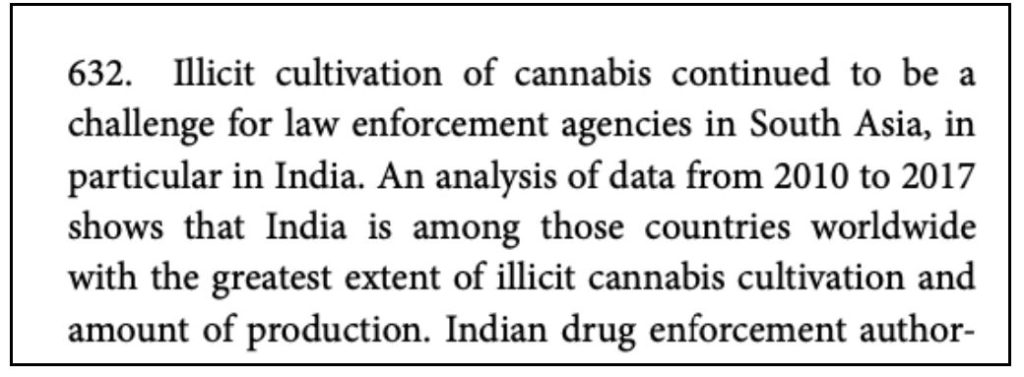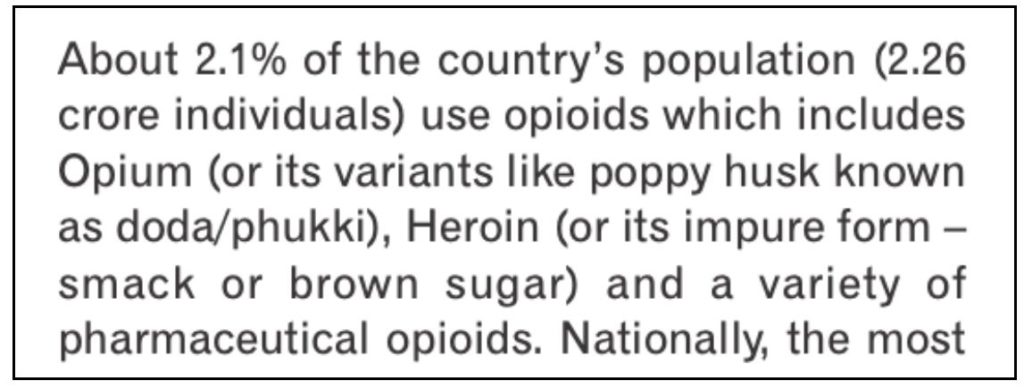One of the reasons for many legislations to be ineffective is lack of swift & timely disposal of cases. The NDPS act is no exception. Five-year data from 2014 to 2018 indicates that more than 83% of the NDPS cases were pending in courts. The actual number of pending cases has only been increasing year after year.
In an earlier story, we analysed the trends of police disposal of cases under the NDPS Act. We have noticed that, over the five-year period i.e. 2014-18, the proportion of cases charge-sheeted by the police and moved to the courts has increased. This has effectively reduced the share of these cases that are pending investigation at the police end.
While the increased disposal at the police end is appreciable, the overall situation can only be ascertained by looking at the trend of disposal of these cases in the courts.
In this story, we take a look at the court disposal of the cases booked under the NDPS Act. The information available in the annual Crime in India reports published by the NCRB ( National Crime Records Bureau) is considered even for this analysis.
More than 83% of the NDPS cases with the courts are pending trial
At the beginning of 2014, a total of 1.18 lakh cases booked under the NDPS Act, were pending for trial in the courts. By the end of the year, the number of such cases increased to around 1.3 lakh i.e. 83.1% of the total cases that were up for trial in the courts for the year.
During the same year, the number of new cases which came up for trial was around 39 thousand. In the ensuing years, the number of new cases up for trial increased continuously. In 2015, there has been a significant jump with 50.8 thousand new cases. In the next three-year period i.e. 2016-18, the number of new cases that came up for trial in the courts was 50.3 thousand, 56.4 thousand and 60.1 thousand respectively.
Although the trial was complete in only around 26.6 thousand cases in 2014, this number increased significantly in the next two years with trials completing in 35.2 thousand and 37.1 thousand cases respectively.
It ought to be noted that, the number of cases (around 1.5 thousand) which were disposed of without trial in 2016 was comparatively higher than the previous and subsequent years.
In 2017, the number of cases disposed of was 34.1 thousand & in 2018, the number went up to 38.5 thousand. Apart from cases that were disposed of without trial, the cases disposed of include cases where the accused were ‘Discharged/Acquitted’ and those where the accused were ‘Convicted’.
The number of convictions was around 19 thousand in 2014, which increased to 26.5 thousand in 2015. After a fall in the convictions in the next two years, it increased to 28.3 thousand in 2018. Meanwhile, the number of cases that were disposed of as ‘Discharged/Acquitted’ increased from 6.7 thousand in 2014 to 9.7 thousand in 2018.
Since a higher number of cases were disposed of in 2015, the pendency rate came down from 83.1% to 80.6 %. This slightly increased to 81.3 % in 2016. By 2017, the proportion of pending cases increased to 83.7%, with only a slight fall in 2018 to 83.6%. The higher pendency in both 2017 & 2018, is a result of an increase in the number of new cases for trial and the lack of a proportionate increase in the disposal of cases. It has to be noted that the pendency rate of all the crimes covered under SLL laws was 82.6 % in 2018.
Increase in the proportion of pending cases in Metro cities
In 2016, the number of new cases under the NDPS Act in Metro cities, that came up for trial was around 17 thousand. As highlighted in earlier stories, NCRB’s CII report enlists 19 cities as metro cities. This number fell in the next two years when around 15.4 thousand and 15 thousand cases came up for trial in 2017 & 2018 respectively.
Despite the fall in new cases for trial, the number of pending cases increased from 35.8 thousand in 2016 to 47.2 thousand in 2018. This increase in the number of pending cases can be attributed to two factors. The first one being a significant decrease in the number of cases that were disposed without trial. In 2016, around 1.4 thousand cases were disposed without trial (compounded). However, in the next two years, only 16 and 175 cases in the metro cities have been disposed without trial.
The second factor is the decrease in the number of cases where the trial is complete. In 2016, the trial was complete in around 11.8 thousand cases, which fell to 8.5 thousand and 9.9 thousand in 2017 & 2018 respectively. This means that there is a significant drop in the total number of cases disposed of by the courts.
The fall in the number of cases disposed of by the courts is reflected both in the number of ‘Convictions’ and number of cases under ‘Discharged & Acquitted’, more predominantly in case of later.
A total of 8.8 thousand cases resulted in conviction in 2016 which fell to 6.5 thousand in 2017. However, this number increased to 8.5 thousand in 2018. The number of cases where the accused were discharged or acquitted was 2.9 thousand in 2016, which fell to 1.4 thousand in 2018.
This increase in the pendency in courts looks prominent in terms of proportion also. In 2016, nearly 73% of the NDPS cases in metro cities were pending with courts, which increased to more than 82% in 2018.
Around 60% of the cases are pending trial in courts for over a year
Out of 1.74 lakh cases under the NDPS act pending trial in the courts by the end of 2017, around 67 thousand were pending for less than a year. The rest of the cases, around 1.07 lakh cases i.e. 60% of the cases were pending for over a year. Of these, 64% of the cases were pending between 1-3 years. More than 3 thousand cases were pending for over 10 years.
In 2018, the number of pending cases with courts under the NDPS act has increased to 1.96 lakh. A corresponding increase is observed across different pending tenures. The major increase is observed for cases pending for ‘6-12 months’ and for ‘3-5 years’.
Meanwhile, there is a drop in the number of cases pending for over 10 years, with 1955 such cases pending by the end of 2018. Data is not available to ascertain if these long pending cases resulted in a conviction or disposal/acquittal.
Lower disposal rate raises serious questions on the effectiveness of the law
The purpose of any crime related legislation is to bring the actual offenders to justice and in the process effect convictions or acquit the innocent after due process of law i.e. impartial police investigation and a fair trial in the courts.
As observed in the earlier story regarding police disposal of the cases booked under NDPS Act, there is an increase in the number of cases being charge-sheeted and hence an increase in the number of cases that came up for trial in courts. However, as the data indicates, the disposal rate in the courts is very low and also shows a declining trend. The higher proportion of the cases pending trial in the courts for over a year is also a cause for concern. The problem of pendency is not limited to cases under the NDPS act and this is a problem across the spectrum. We had earlier analysed pendency in courts in multiple stories which can be read here and here.
The purpose of NDPS Act , was to have a legislation in place which can effectively deal with the illicit drug trade and abuse. However, with a high proportion of the cases pending at the police and majority pending in the courts, the actual disposal rate of these cases is very low. Considering the fact that possession of small quantities of the prohibited drugs attracts a punishment of imprisonment up to 12 months, and consumption may attract a punishment of imprisonment of only up to 6 months, waiting for the court disposal for more than a year raises serious questions about the effectiveness of the legislation in itself and its deterrent effect on drug trade & abuse.
As per data provided by the German Research firm ABCD, in 2018, New Delhi ranks third among the cities in the world in terms of volume of consumption of Cannabis with 38.26 metric tonnes. Mumbai ranks sixth with 32.38 metric tonnes consumption.
As per the International Narcotics Control Board’s Annual Report -2019, India has emerged as the centre for manufacturing of ‘tramadol’ that enters clandestine markets. The report also states that, as per the data between 2010 & 2017, India is among the countries with the greatest extent of illicit cannabis cultivation.

Around 1.2% of the population used illegal Cannabis according to a Government report
As per the ‘Magnitude of Substance Use in India-2019’ report by Ministry of Social Justice and Empowerment, Cannabis and Opioids are the most commonly used substances in India after alcohol. Around 1.2% of the population has used illegal cannabis products – ganja & charas, while around 2.1% of the population has various forms of opioids including opium, heroin etc. These numbers were based on a survey of more than 2 lakh households in 186 districts of the country (covering all states & UTs) and around 4.73 lakh individuals. In addition, a Respondent Driven Sampling (RDS) survey was conducted covering 135 districts and 72,642 people suffering from dependence on illicit drugs.

The extensive use of these prohibited drugs indicates that NDPS has not been fully effective in control of usage and trade of the drugs. Slow disposal & high pendency do not help the cause.
Meanwhile, examples from elsewhere in the world indicate that prohibition of drugs is less effective in the control of the drugs, with de-criminalising and having in place a controlled mechanism could be more effective in regularising drug trade and mitigating drug abuse. The data by German Research group ABCD, also highlights the potential revenues which can be generated by taxing marijuana and other drugs.
Data & evidence indicates that the current policy & execution regime has been ineffective in prohibiting drugs trade & its use in India. It is probably time for the legislature & the government to explore the possibility of regularising a limited number of these drugs which could bring in greater control as well as possible revenue. Such regularization could also reduce the burden on the law enforcement authorities and courts, whose resources can be more effectively used in identifying violations under the new regime.
Featured Image: NDPS cases pending with courts


